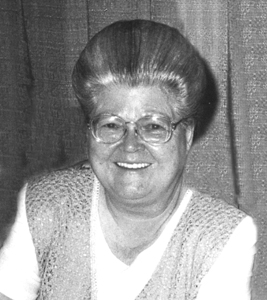NEWS FROM THE HILLS

It is Memorial Day, and the viney honeysuckle spills over the road banks with their remembered sweet fragrance of yesterday. The world celebrated Memorial Day this past Monday, but May 30 will always be Decoration Day to me. Sweet memories of the past and long gone loved ones flood my mind.
It is twilight, and blue shadows are blotting out the day. I hear the lonely “quirr-quirr” of a tree frog somewhere in the nearby trees, and the warm air is full of the scent of sweet clover. In the dim darkness I can see that the “piney” roses are bursting into bloom, ready to be taken to the graveyard.
I am sitting in the same yard where my grandfather and grandmother, mother and dad, rested. The twilight air seems populated with ghosts tonight; I can see them mistily as they used to be. Grandpa has taken his old black hat off and is wiping his face with a red bandanna and remarking, “It shore has been hot today.”
Grandma picks up her sunbonnet and walks toward the house, her long white apron held by the edges and filled with early peas she has shelled while it was still daylight. I remember them, and I miss them. Still, they lived a full life span and died at a ripe old age. It is the ones whose lives have been cut short that we mourn most.
May 30, 1953, one of Clay Counties’ young boys was killed in action in Korea. He was just past 18, in the first flush of manhood. It was a fate that so many of our mountain boys have suffered, in wars down through the years. He was special to us, as each one who has died has been special to their families.
Memorial Day was first called Decoration Day. All down through the ages, people have decorated the graves of their loved ones, but Memorial Day is primarily to honor those who died in military service. It had its roots in the practice of women decorating the graves of their loved ones who had died in the Civil War. April 25, 1866, a women’s association decorated the graves of both Union and Confederate soldiers. In a nation trying to find a way to move on after a war that split the country, states, communities and even families, this gesture was welcomed as a way to lay the past to rest while honoring those who fought on either side.
Commander-in-Chief John A Logan of the Grand Army of the Republic issued a proclamation in 1868 declaring the first Decoration Day. On May 30, 1870, he gave an address in honor of the new commemorative holiday. In it he said, “This Memorial Day, on which we decorate their graves with the tokens of love and affection, is no idle ceremony with us to pass away an hour. But it brings back to our minds in all their vividness the fearful conflicts of that terrible war in which they fell as victims.
“Let us then all unite in the solemn feelings of the hour, and tender with flowers the warmest sympathies of souls! Let us revive our patriotism and love of country by this act, and strengthen our loyalty by the example of noble dead around us . . . “
The reality and sadness of the Civil War that split our state and sometimes pitted brother against brother was brought home to us by the remains of a battleground in Pocahontas County called Camp Allegheny. We had been camping at Deer Creek when brother-in-law Jim took us to an isolated place at the top of the Allegheny Mountain.
It was a saucer-like depression that once was, and still is, an open sheep meadow, and has remained undisturbed for more than 145 years. There was a marker that stated, “Confederate forces led by Col. Edward Johnson held a fortified camp here in the winter of 1861-62. Sharp attack occurred December 13, 1861, in which the Union troops under Gen. Robert Milroy were beaten off.”
An account of the battle reads as follows: “In a piercing winter wind, fighting continued much of the sunny morning as each side maneuvered on the hillside fields and woods to gain the advantage. On the right flank, Milroy had posted a strong force in a mountain clearing, among the fallen timber, brush and stumps which proved to be too difficult for the Confederate infantry to drive off.
“A Confederate artillery battery unlimbered and unleashed a ‘storm of round shot and canister among them, knocking their timber defenses about their heads and making their nest too hot to hold them . . .’ Finally Milroy’s troops were repulsed, and he retreated to his camps at Green Spring Run near Cheat Mountain. The losses were high, with an estimated 283 casualties—146 Confederate soldiers, and 137 Union soldiers.”
We walked around the perimeter of the meadow to a grove of trees on the left side. There we found a sad cemetery—sunken depressions and small wooden crosses marking the fallen ones. Many were as young as 16 and 17, and many of the markers were broken and missing. It was a scene to make the heart break, to think of those young men now forgotten.
Most of the graves were unidentified, although there were a few headstones that marked certain graves. We stood there in solemn reverence, thinking of the terrible war that tore our country apart, and the young men who had given their lives. Their names may be forgotten, their earthly remains turned to dust, but God has not forgotten them.
This portion of a poem written by Francis Miles Finch pulls at the heartstrings, and reminds us of the ultimate sacrifice made by our brave young men.
THE BLUE AND THE GRAY
By the flow of the inland river,
Whence the fleets of iron have fled,
Where the blades of the grave-grass quiver,
Asleep are the ranks of the dead:
Under the sod and the dew,
Waiting the judgment –day;
Under the one, the Blue,
Under the other, the gray.
From the silence of sorrowful hours
The desolate mourners go,
Lovingly laden with flowers
Alike for the friend and the foe;
Under the sod and the dew,
Waiting the judgment-day;
Under the roses, the Blue,
Under the lilies, the Gray.
So, when the summer calleth,
On forest and field of grain,
With an equal murmur falleth
The cooling drip of the rain:
Under the sod and the dew,
Waiting the judgment-day,
Wet with the rain, the Blue
Wet with the rain, the Gray.
- Celebrating 20 Years Of Community At The Stand - April 12, 2024
- First Positive Case Of Chronic Wasting Disease In Indiana - April 12, 2024
- Southwest Allen County Schools Embark On Major Tree Plantings - April 12, 2024


